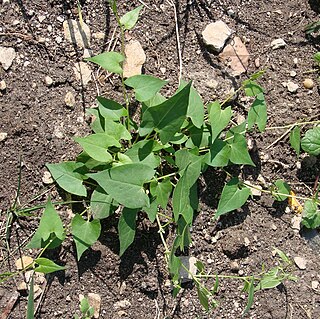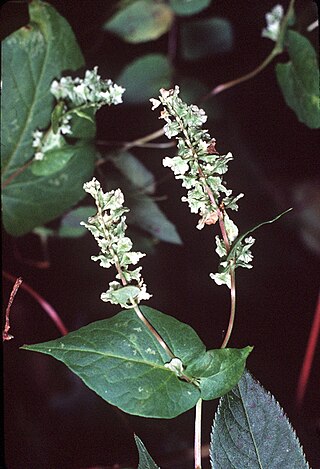
Reynoutria japonica, synonyms Fallopia japonica and Polygonum cuspidatum, is a species of herbaceous perennial plant in the knotweed and buckwheat family Polygonaceae. Common names include Japanese knotweed and Asian knotweed. It is native to East Asia in Japan, China and Korea. In North America and Europe, the species has successfully established itself in numerous habitats, and is classified as a pest and invasive species in several countries.

Polygonum is a genus of about 130 species of flowering plants in the buckwheat and knotweed family Polygonaceae. Common names include knotweed and knotgrass. In the Middle English glossary of herbs Alphita, it was known as ars-smerte. There have been various opinions about how broadly the genus should be defined. For example, buckwheat has sometimes been included in the genus as Polygonum fagopyrum. Former genera such as Polygonella have been subsumed into Polygonum; other genera have been split off.

Fallopia convolvulus, the black-bindweed or wild buckwheat, is a fast-growing annual flowering plant in the family Polygonaceae native throughout Europe, Asia and northern Africa.

Fallopia is a genus of about 12 species of flowering plants in the buckwheat family, often included in a wider treatment of the related genus Polygonum in the past, and previously including Reynoutria. The genus is native to temperate and subtropical regions of the Northern Hemisphere, but species have been introduced elsewhere. The genus includes species forming vines and shrubs.

Saul of the Mole Men is an American live-action/puppet/animated hybrid comedy television series created by Craig Lewis, former writer on Cartoon Network's The Grim Adventures of Billy and Mandy and Foster's Home for Imaginary Friends. The series first aired on the channel's late night Adult Swim programming block on February 11, 2007. Described as "an ultra-patriotic Land of the Lost set in the center of the Earth", the series was directed by Tom Stern and stars Josh Gardner, who previously collaborated with Stern on the television series Gerhard Reinke's Wanderlust. Its theme song is performed by South Park co-creator Trey Parker.

The Coleophoridae are a family of small moths, belonging to the huge superfamily Gelechioidea. Collectively known as case-bearers, casebearing moths or case moths, this family is represented on all continents, but the majority are found in temperate areas of the Northern Hemisphere. They are most common in the Palearctic, and rare in sub-Saharan Africa, South America, and Australia; consequently, they probably originated in northern Eurasia. They are relatively common in houses, they seek out moist areas to rest and procreate.

Coleophora is a very large genus of moths of the family Coleophoridae. It contains some 1,350 described species. The genus is represented on all continents, but the majority are found in the Nearctic and Palaearctic regions. Many authors have tried splitting the genus into numerous smaller ones, but most of these have not become widely accepted.

Reynoutria sachalinensis is a species of Fallopia native to northeastern Asia in northern Japan and the far east of Russia.
× Reyllopia is a hybrid genus with a single known species, × Reyllopia conollyana, the Haringey knotweed or railway-yard knotweed. The species is a hybrid between Japanese knotweed and the Russian vine. The only known wild British population was discovered by David Bevan at Railway Fields in 1987.

Coleophora serratella is a moth of the family Coleophoridae. It is found in Europe, Japan (Hokkaido) and North America.
Aphalara itadori, the Japanese knotweed psyllid, is a species of psyllid from Japan which feeds on Japanese knotweed.

Fallopia baldschuanica is an Asian species of flowering plant in the knotweed family known by several common names, including Russian-vine, Bukhara fleeceflower, Chinese fleecevine, mile-a-minute and silver lace vine. It is native to Asia, and is growing wild in parts of Europe and North and Central America as an introduced species.

The metallic coleophora moth is a moth of the family Coleophoridae. It is native to Europe and Armenia, but is an adventive species in the Nearctic realm, where it is found throughout the United States and southern Canada. It has also been recorded from New Zealand, Chile and Argentina.
Coleophora dianthi is a moth of the family Coleophoridae. It is found in most of Europe, Russia, Turkey and Iraq.
Coleophora pratella is a moth of the family Coleophoridae. It is found from France and Belgium to Latvia, Lithuania, Poland, Romania and Bulgaria and from Germany to Italy, Austria and Hungary.

Coleophora borea is a moth of the family Coleophoridae. It is found in the United States, including Ohio.

Monochroa sepicolella is a moth of the family Gelechiidae. It is found from central and northern Europe to the Ural Mountains, the Caucasus and southern Siberia.

Fallopia scandens, the climbing false buckwheat, is a species of Fallopia native to North America. It is a herbaceous perennial plant which grows from to 1–5 m (3–16 ft) tall. Although they are semi-erect during bloom, when they are producing fruit, they hang from their pedicels in a downward position. Both the fruit and flower are greenish-white in appearance. In North America, it is often misidentified with Fallopia dumetorum, a species endemic to Europe.

Polygonoideae is a subfamily of plants in the family Polygonaceae. It includes a number of plants that can be highly invasive, such as Japanese knotweed, Reynoutria japonica, and its hybrid with R. sachalinensis, R. × bohemica. Boundaries between the genera placed in the subfamily and their relationships have long been problematic, but a series of molecular phylogenetic studies have clarified some of them, resulting in the division of the subfamily into seven tribes.

Fallopia dumetorum, also known as copse bindweed, is a species of flowering plant in the family Polygonaceae, native to temperate Eurasia.














